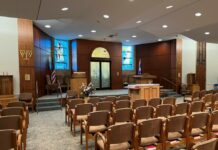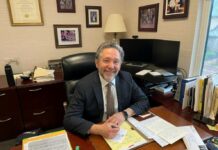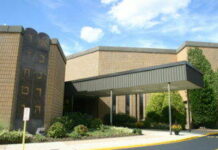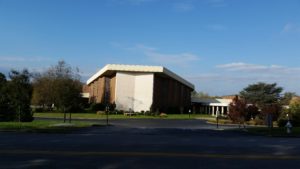
Har Zion Temple opened in 1923 in West Philadelphia’s Wynnefield neighborhood. Next year, the synagogue, now in Penn Valley, will celebrate its centennial.
And over those 99 years, the congregation has made great contributions to the Philadelphia-area Jewish community. According to the synagogue’s history section on its website, members “were instrumental” in the creation of the Perelman Jewish Day School, the Jack M. Barrack Hebrew Academy and Camp Ramah in the Poconos. They also opened the “first afternoon religious school accredited by the United Synagogues of Conservative Judaism.”
Today, that legacy is in the hands of Har Zion’s 720 family units and its three leaders: Rabbi Seth Haaz, Cantor Eliot Vogel and President Josh Friedman. Haaz arrived in 2018 from a synagogue in Connecticut, but Vogel and Friedman are fixtures, having joined the community in 1991 and 1994, respectively.
Yet all three understand this history and the challenge they face. They also believe that they, along with their congregants, know how to continue the legacy into the next century.
Just a few months ago, the community unveiled its new mission statement on its website. It is, according to the leaders, a reflection of the congregation’s values as it looks ahead.
Several values are listed, but two stand above the others, Haaz explained. Those are inclusivity and community.
“We’re each on our own journey, and, as members of a Jewish community, we go on this journey together,” he said.
This congregation-wide conversation started because the leaders felt that COVID drove people away from communities. But it would have been appropriate even before COVID because Jews were leaving their communities anyway, according to Haaz. At Har Zion, the congregation has shrunken from around 1,500 family units after World War II to its current number of about half that.
Community, as Haaz explained, has become “a countercultural concept.” But that is also the time when it is “most needed.”
“It’s when we look at students struggling with mental health; when we look at seniors struggling with isolation; and when we look at friends who haven’t seen each other in years,” the rabbi said. “We want to bring people back to the synagogue.”

To do that, Haaz, Vogel and Friedman need to turn Har Zion into a temple that people want to join. Since releasing that mission statement, they have made several changes to try and live up to its values.
Recently, the synagogue held its first-ever Pride event: a screening of a movie about a gay Israeli man who relocates to London after being rejected by his family. The temple also established an inclusivity committee. The five-person group aims to “address various communities who might not know how welcome they are,” Haaz said. Congregants want “everyone to be part of the (Har Zion) community,” he added.
Towards that same end, synagogue leaders changed the name of the bar and bat mitzvah program to a B mitzvah program. Haaz said the temple wants to recognize that “bar and bat is very binary and not everybody fits into that.”
Deeper than the name, though, the rabbi and his team are working to make the process more communal. No longer do students study one-on-one with a tutor. Instead, they learn in a group. This way, they can celebrate “each other’s accomplishments,” the rabbi explained.
Leaders are trying to create a similar environment across the rest of synagogue life. They are building a covered outdoor space so congregants can gather even during a situation like COVID, according to Haaz. They are renovating their outdoor playgrounds to make equipment more accessible and to add more tree and nature sections. They are also building a hiking trail behind the synagogue “so we can journey and spend time together,” Haaz said.
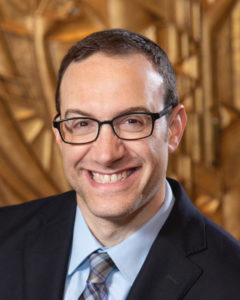
Perhaps most importantly, the synagogue is changing its membership structure to make it less hierarchical. In the past, congregants paid for memberships based on where they sat for High Holiday services. The better the seat, the more you paid, with three sections in all.
Now, dues are just based on the number of individuals who are joining from each family.
“Har Zion membership is not just about those three days of the year,” Friedman said. “It’s about a life cycle.”
This is a fundamental change, according to Vogel. The cantor said that in the past, people may have “joined because their kids went to preschool here.” But not because it was a place for adults to feel “seen” in their Jewish journeys.
Today and moving forward, synagogues need to do more seeing, the cantor believes.
“Synagogue is not just a thing to be consumed when you need it,” Vogel said. “It’s not so transactional.” JE



